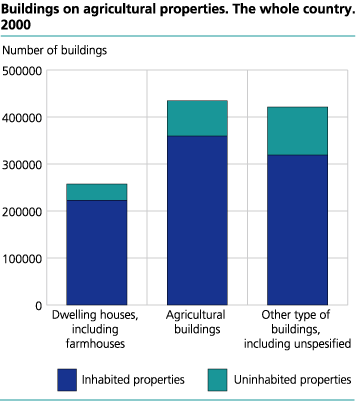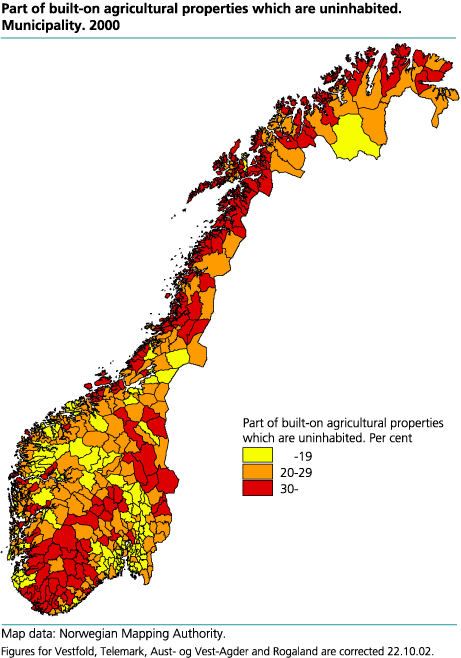Content
Published:
This is an archived release.
Many empty buildings on agricultural properties
Every fifth building on agricultural properties belongs to properties that are uninhabited. About 26 per cent of 183 000 built-on agricultural properties are uninhabited. Units with less than 50 decares agricultural area compose the largest part of uninhabited properties.
Preliminary figures show that for the year 2000, there are 1 114 000 buildings on agricultural properties. 212 000 of these buildings are on properties which are uninhabited. About 34 000 of these buildings are dwelling houses; which is 13.5 per cent of the total number of dwelling houses located on agricultural properties. Some of these might however be in use as holiday houses. About half of the dwelling houses on agricultural properties are located on properties whose owner does not work the agricultural area himself. The area is either out of use or rented out to other farmers.
From the mass of buildings located on agricultural properties 23, per cent are dwelling houses, 39 per cent agricultural buildings and 38 per cent other types of buildings, including buildings missing a code for type of building. About 20 per cent of all these buildings have protection status registered as part of cultural heritage.
One out of four agricultural properties are uninhabited
About 46 600 built-on agricultural properties do not have people living there permanently. This is 25,5 per cent of all built-on agriculture properties. In the counties surrounding Oslo about 15 per cent of the properties are uninhabited, while in one of the counties in the northern part of the country, 36 per cent of the properties are uninhabited. The variation within the counties is large from municipality to municipality. A typical agricultural municipality around Mjøsa and Jæren has a lower per cent of uninhabited agricultural properties compared to the municipalities in Agder and along the coast of northern Norway. More than 18 000 agricultural properties have no buildings located on them. The material on which this statistic is based includes all agricultural properties in the administrative Farm Register, without regard to size of property by agricultural area or productive forest area.
Most uninhabited among small properties
Among built-on agricultural properties with less than 50 decares of agricultural area, more than 30 per cent are uninhabited. Many of these properties are farms whose owner does not work the agricultural area. The area is either out of use or rented out to other farmers. The total agricultural area and the size of properties have not changed much over time. However, active holdings with agricultural area in use have reduced from 155 000 units in 1969 to 71 000 units in 1999. On built-on properties where the owner does not work the land about 35 per cent are uninhabited. For properties where the agricultural area is in use the comparable figure is 10 per cent. For units with more than 500 decares agricultural area in use the comparable figure is 6 per cent.
Background
The cultural landscape is influenced by changes in the use of agricultural properties and buildings located on them. What happens with inactive farms has until now only been sparsely covered by traditional agricultural statistics. The results presented here are build on the linkage of agricultural properties from the administrative Farm Register, buildings from The Official Ground Property-, Address- and Building register (GAB) and information about people from The Central Population register. The buildings protection status is included through a link to buildings registered in the cultural heritage register (SEFRAK). In particular, this register includes buildings which are over 100 years old.
More information about the project is given in SSB Reports 2002 / 28 Agricultural buildings 2000 . Linking of the registers is not perfect and the quality of the results cannot be better than the quality of the individual. As the development of agricultural properties, ownership, buildings and habitation is to be followed over time, the experience of this project will be fundamental to the production of yearly statistics concerning agricultural properties.
Tables:
Additional information
Agricultural properties on grids (1km, 5km)
Contact
-
Trond Amund Steinset
E-mail: trond.amund.steinset@ssb.no
tel.: (+47) 40 81 13 73


